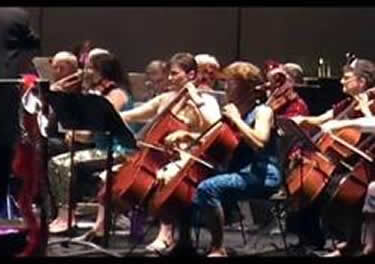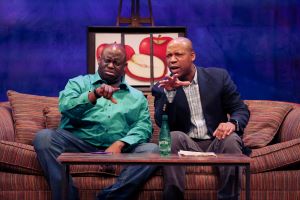Speaking before the intriguing March 23 performance of George Enescu’s String Octet in C Major, Op. 7, Ara Gregorian, director of the ECU’s Four Seasons Chamber Music Festival, said that he loved the piece more each time he performed it – no wonder, since he was about to play a viola part with a boldly prominent line, thus belying the instrument’s customary role as an “inner voice.” The eight members of Concertante – violinists Jennifer Fautschi, Matilda Kaul, Ittai Shapira and Xiao-Dong Wang, violists Gregorian and Rachel Shapiro, and cellists Sophie Shao and Zvi Plesser – formed a hollow arc on the A.J. Fletcher Recital Hall stage. Perhaps in order to emphasize the first viola, the violists were separated by three other players, with Gregorian anchoring the right end, opposite the first violin.
In his autobiography, Enescu wrote that his Second Violin Sonata (1899) and this Octet were among the first works in which he started “becoming himself.” In the New Grove II , Noel Malcom writes that the Octet “combines rich late-Viennese chromaticism with ferocious contrapuntal energy.” After finding the possibilities offered by the task of “setting” Romanian songs and dances limiting, the focus of the composer’s musical language was on “new ways of developing, and combining, pure melodic lines.” Continuing, Malcom writes that “The doina , a type of meditative song, frequently melancholic, with an extended and flexible line in which melody and ornamentation merge into one,” was particularly influential. For Enescu, “melodic line was the vital principal of music.” In his autobiography, he wrote, “I’m not a person for pretty successions of chords…. [A] piece deserves to be called a musical composition only if it has a line, a melody, or, even better, melodies superimposed on one another.” Malcolm observes that, in the last movement of the Octet, all the “melodic elements of the work return, to be piled one on top of another.” The four movements are played without pause, enhancing the overarching sonata structure. Concertante managed to keep the potentially thick scoring very clear and perfectly balanced. The first movement’s muted strings were memorable, playing a charming lullaby. Even more subtly sublimated than Ravel’s “La Valse,” the last movement tweaks the senses with its indirect waltz. This work ought to be as popular and well known as Mendelssohn’s Octet, and Concertante should record it.
The Octet is hardly “new music,” but it opened this concert, the first of eight, packed into a week, that featured visiting ensembles and ECU faculty and students, bolstered by masterclasses, seminars, and readings of student compositions. The annual festival this year reflected close co-ordination and partnership between Edward Jacobs’ celebrated NewMusic@ECU Festival and Gregorian’s work in chamber music.
The eight players began the concert with Praeludium and Scherzo by the nineteen-year-old Dmitri Shostakovich. Some of the somber mood of his later mature symphonies could be heard in the opening movement, while his “satiric edge” was prominent in the sassy fast movement. This short work makes an excellent introduction or encore for an octet.
Polish-born composer Jan Radzynski (b.1950), currently Professor of Composition at Ohio State University in Columbus, composed “Five Duets” (1992) as a birthday present for Andre Hajdu, a noted Hungarian-born, Jerusalem-based composer. In New Grove II, Ronit Seter characterizes the composer’s style as encompassing “long and expressive melodic lines, rich textures, chromatic sighing motifs, through-composed yet solid structures and witty virtuoso writing…” that “incorporate Middle Eastern [and] quasi-Arabic elements into his Jewish style.” Cellists Plesser and Shao played the duets, revealing subtle and not-so-subtle allusions to Hajdu’s work with Kodály, Messiaen, and Milhaud and to his early studies of Gypsy music. Most attractive was the fourth duet’s allusion to the Spanish Jews, the Sephardic exiles.
Of all the students he had known at Juilliard, Gregorian said that fellow Concertante member Shapira (his roommate) had been the most compulsive about practicing. From time to time, tiring of the slow, methodical exercises, he would have a “concerto night” consisting of four hours of every concerto that he knew. “Virtuoso Variations,” the first composition by Shapira (b.1972), is very much in the showpiece tradition of 19th-century stars such as Paganini, Sarasate, and Wieniawski. Added treats for violin students (and record collectors) are fleeting allusions to famous violinists’ interpretations of this type of repertory, such as Milstein’s Paganini, Perlman’s Vieuxtemps, etc. A welcome addition to the violinist’s arsenal, these variations featured almost every imaginable technique including multiple stops, use of the extreme high positions, etc.
I first reviewed Frautschi when she appeared as a member of the Caramoor Virtuosi on the 2000 and 2001 Piccolo Spoleto series in Charleston, S.C. Since then she has added an Avery Fisher Career Grant to her impressive and expanding resume. She prefaced her performance of “Secret Psalm” (2003), by Oliver Knussen (b.1952), with a few words about its origin. It was originally written in 1990 for Nona Liddell to play at the memorial concert for Michael Vyner, Artistic Director of the London Sinfonietta. According to a note by Knussen, Vyner had been a violinist who, despite playing with a cutting-edge ensemble, “loved the slow movement of one very well-known concerto, which provided the starting point for the three ‘verses’ of this short meditation.” In 2003, he reworked the piece for a retrospective of his chamber music, and Frautschi gave its U.S. premiere. It is an appealing addition to the solo repertoire, and Frautschi made the best possible case for it with eloquent and moving phrasing and flawless intonation.












